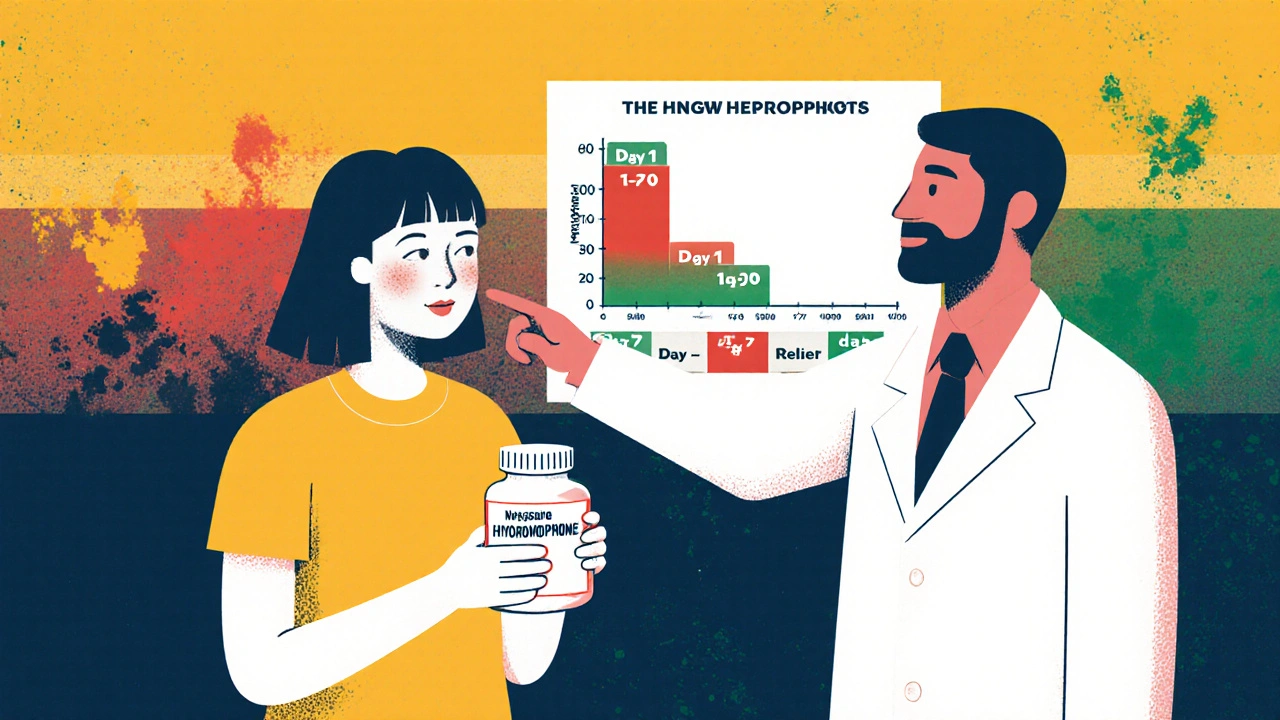Nausea Relief Calculator for Opioids
Opioid-induced nausea is common, but you can manage it effectively with the right timing and approach. This tool helps calculate the best antiemetic timing based on your opioid schedule and provides personalized recommendations.
Nausea Relief Calculator
Recommended Approach
Select an antiemetic and enter your opioid timing to see the optimal schedule.
Opioid Peak Timing
Antiemetic Comparison
Prochlorperazine
A gentle first-line option that targets the brain's vomiting center. Works well for most people with minimal movement side effects. Available as pill, suppository, or injection.
Best Practice
Most experts recommend: Start with prochlorperazine or haloperidol. Take the antiemetic 30-60 minutes before your opioid dose. This timing trick can cut nausea in half for many people. Don't take antiemetics daily unless you're feeling sick.
When you start taking opioids for pain, nausea isn’t just an inconvenience-it can make you stop the medication altogether. About one in three people who begin opioid therapy feel sick to their stomach, sometimes so badly they vomit. This isn’t rare. It’s expected. And it’s not always about the drug itself-it’s about how your body reacts, when you take it, and what you eat. The good news? You don’t have to suffer through it. With the right approach, most people get past this within a week.
Why Opioids Make You Nauseous
Opioids like morphine, oxycodone, and hydrocodone don’t just block pain signals. They also bind to receptors in a part of your brain called the chemoreceptor trigger zone. This area doesn’t care if you’re in pain-it just reacts to chemicals in your blood. When opioids activate it, your brain thinks you’ve swallowed poison and triggers nausea and vomiting. It’s a reflex, not a sign you’re allergic or overdosing. This reaction hits hardest in the first 24 to 48 hours after starting or increasing a dose. After that, your brain usually adjusts. Most people develop tolerance in 3 to 7 days. But if you’re not prepared, those first few days can feel unbearable. And if nausea isn’t handled early, it can lead to skipping doses, poor pain control, or even quitting opioids entirely-which is why 30% to 35% of cancer patients stop using them because of nausea, according to studies reviewed in the Journal of Palliative Medicine.Which Antiemetics Work Best
Not all nausea medicines are the same when it comes to opioid-induced nausea. The right choice depends on your age, other medications, and what’s causing the nausea-your brain, your stomach, or both.- Haloperidol (0.5-2 mg daily): A low-dose antipsychotic that blocks dopamine in the brain’s vomiting center. It’s cheap-about 5 cents per pill-and works well for many. But it can cause stiffness or tremors, especially in older adults. Avoid if you have Parkinson’s.
- Prochlorperazine (5-10 mg every 6-8 hours): A phenothiazine that’s gentler than haloperidol. Often used as a first-line option because it’s effective and less likely to cause movement problems. Available as a pill, suppository, or injection.
- Metoclopramide (5-10 mg every 6-8 hours): This one works on your stomach. It speeds up digestion, which helps if nausea comes from slow gut movement-a common side effect of opioids. It’s the only prokinetic drug available in the U.S. for this use. But don’t use it long-term: it can cause muscle spasms or restlessness in 10-15% of users.
- Ondansetron (4-8 mg every 8 hours): Often used for chemo nausea, it blocks serotonin. But for opioid nausea? Studies show it’s only moderately helpful. It’s expensive-up to $3.50 per tablet-and not the best value for this specific problem.
- Dexamethasone (4-8 mg daily): A steroid that helps some people, but no one fully understands why. Used more often in cancer care, it’s not a go-to for everyday opioid users.
Most experts agree: start with prochlorperazine or haloperidol. They target the brain’s trigger zone directly. Metoclopramide is a good second choice if you feel bloated or full after eating. Avoid ondansetron unless other options fail.
Timing Matters More Than You Think
Taking your antiemetic at the same time as your opioid isn’t enough. You need to beat the opioid to the punch. Opioids peak in your bloodstream about 60 to 90 minutes after you swallow them. That’s when nausea hits hardest. So if you take your antiemetic 30 to 60 minutes before your opioid dose, it’s already working when the opioid arrives. For example:- Take prochlorperazine at 8:00 a.m.
- Take oxycodone at 9:00 a.m.
This timing trick can cut nausea in half for many people. It’s simple, free, and doesn’t require more drugs. But most patients don’t know this. A 2019 survey found that only 40% of primary care doctors even mention timing when prescribing antiemetics.

Diet Adjustments That Actually Help
What you eat can make nausea worse-or better. Opioids slow down your gut. That means food sits longer, causing bloating, gas, and discomfort. That’s not just constipation-it’s nausea fuel. Here’s what works:- Eat small, frequent meals. Instead of three big meals, try five or six tiny ones. A large plate of food overwhelms a sluggish stomach.
- Avoid greasy, spicy, or sweet foods. These slow digestion even more and can trigger nausea. Stick to plain, bland foods: toast, rice, bananas, broth.
- Drink fluids between meals, not with them. Drinking while eating fills your stomach faster and can make you feel nauseous. Sip water, ginger tea, or clear broth an hour before or after eating.
- Try ginger. A 2020 review in Annals of Palliative Medicine found ginger (1 gram daily in capsule or tea form) helped reduce nausea in 60% of opioid users. It’s not a replacement for medicine, but it’s a safe, natural boost.
- Don’t lie down after eating. Stay upright for at least 30 minutes. Gravity helps keep food moving.
One patient I worked with, a 68-year-old with back pain, stopped vomiting after switching from three large meals to six small ones and adding ginger tea. He didn’t change his opioid dose. Just his plate.
When to Switch Opioids
If nausea sticks around past a week, even with antiemetics and diet changes, it might be time to switch opioids. Not all opioids cause the same level of nausea.- Morphine is the worst offender. It’s strong, cheap, and widely used-but also the most likely to cause nausea.
- Oxycodone is slightly better. Some people switch from morphine to oxycodone and notice a drop in nausea.
- Hydromorphone and methadone are even better options. Studies show switching from morphine to hydromorphone reduces nausea in 40-50% of cancer patients, according to the National Comprehensive Cancer Network’s 2023 update.
- Methadone is trickier. It requires careful dosing because it builds up in your system. Only a pain specialist should handle this switch.
Don’t switch on your own. Talk to your doctor. But know this: if you’re still nauseous after 7-10 days, it’s not just “getting used to it.” It might be the drug.

Prophylaxis Doesn’t Work-Treatment Does
Many doctors prescribe antiemetics “just in case” when starting opioids. But here’s the truth: giving antiemetics before nausea starts doesn’t prevent it. A 2019 meta-analysis of 619 patients found dopamine blockers like haloperidol had no preventive effect (p=0.037). They only work once nausea is already there. So don’t take them every day unless you’re feeling sick. Use them as needed. Take them 30-60 minutes before your opioid, only on days you feel nauseous. This saves money, reduces side effects, and keeps you in control.What If Nothing Works?
If you’ve tried antiemetics, timing, diet, and even switched opioids-and you’re still nauseous-you’re not alone. About 42% of cancer patients stop opioids because of uncontrolled nausea, according to research in the Journal of Clinical Oncology. At this point, you need a pain specialist. Ask for:- A review of your total opioid dose. Sometimes, lowering your dose by 25-33% still gives you good pain relief but cuts nausea by 60%.
- A trial of 6β-naltrexol, an experimental drug still in trials. Early studies show it blocks opioid-induced nausea without reducing pain relief.
- A referral to a palliative care team. They specialize in managing these side effects and can adjust your plan without giving up pain control.
Don’t accept nausea as part of the deal. You deserve pain relief without suffering.
Bottom Line: What to Do Today
If you’re starting opioids or struggling with nausea right now:- Ask your doctor for prochlorperazine or haloperidol-not ondansetron.
- Take the antiemetic 30-60 minutes before your opioid.
- Switch to small, bland meals. Avoid greasy food and drink between meals.
- Add ginger tea or capsules (1 gram daily).
- If nausea lasts more than 7 days, ask about switching to hydromorphone or methadone.
- Don’t take antiemetics daily unless you’re nauseous.
Opioid nausea isn’t inevitable. It’s manageable. With the right tools, you can control it-and keep doing what matters most: living with less pain.
How long does opioid-induced nausea last?
For most people, opioid-induced nausea lasts 3 to 7 days after starting or increasing the dose. The body usually builds tolerance during this time. If nausea continues beyond a week, it’s not normal tolerance-it’s likely a sign you need a different antiemetic, a dose adjustment, or a different opioid.
Can I take ginger with my opioid and antiemetic?
Yes. Ginger is safe to use alongside opioids and most antiemetics like prochlorperazine or metoclopramide. Studies show 1 gram of ginger per day (in tea, capsules, or candy form) reduces nausea in about 60% of opioid users. It’s a helpful, low-risk addition-not a replacement for medical treatment.
Is it safe to stop my antiemetic after a week?
Yes, if your nausea has improved. Most people don’t need antiemetics long-term because tolerance develops. Stop the antiemetic once you’ve had at least 3-5 days without nausea. If nausea returns, restart it and talk to your doctor. Don’t keep taking it “just in case”-it increases side effect risks without benefit.
Why is metoclopramide not recommended for older adults?
Metoclopramide can cause serious muscle side effects-like tremors, stiffness, or involuntary movements-in people over 65. These are called extrapyramidal symptoms. The risk increases with higher doses and longer use. For older patients, doctors usually prefer prochlorperazine or haloperidol instead, unless they have severe delayed stomach emptying.
Can I use over-the-counter nausea medicine like Pepto-Bismol?
Pepto-Bismol (bismuth subsalicylate) won’t help opioid-induced nausea. It works on stomach irritation or diarrhea, not the brain’s vomiting center. Opioid nausea is neurological, not digestive. Stick to prescription antiemetics like prochlorperazine or metoclopramide. OTC meds are unlikely to help and may interact with other drugs.
What’s the cheapest antiemetic for opioid nausea?
Haloperidol is the most cost-effective option. Generic tablets cost about 5 cents per 0.5 mg dose. Prochlorperazine is also inexpensive, often under $1 per tablet. Ondansetron and branded versions can cost $3-$5 per tablet. For most people, haloperidol or prochlorperazine is both the best and cheapest choice.


Jennifer Shannon
Okay, I just read this whole thing, and I’m honestly blown away-like, not just because it’s informative, but because it feels like someone finally sat down and said, ‘Look, this is real life, not a textbook.’ I’ve been on opioids for chronic back pain for over two years, and the nausea? Oh, it was brutal. I tried everything-Pepto, ginger candies, even that weird tea my aunt swore by-and nothing worked until I started taking prochlorperazine 45 minutes before my dose. I didn’t even know timing mattered that much. It’s like the difference between trying to catch a train after it’s left the station versus showing up with your ticket already in hand. Also, the bit about small meals? Game-changer. I used to eat like I was preparing for a famine, and now I snack on rice cakes and bananas all day. No more vomiting before lunch. Thank you.